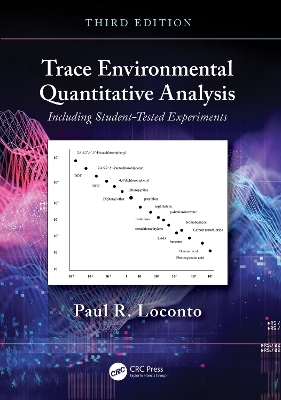
Trace Environmental Quantitative Analysis
CRC Press (Verlag)
978-0-367-63106-2 (ISBN)
A thorough and timely update, this new edition presents principles, techniques, and applications in this sub-discipline of analytical chemistry for quantifying traces of potentially toxic organic and inorganic chemical substances found in air, soil, fish, and water, as well as serum, plasma, urine, and other body fluids. The author addresses regulatory aspects, calibration, verification, and the statistical treatment of analytical data including instrument detection limits; quality assurance/quality control; sampling and sample preparation; and techniques that are used to quantify trace concentrations of organic and inorganic chemical substances.
Key Features:
Fundamental principles are introduced for the more significant experimental approaches to sample preparation
Principles of instrumental analysis (determinative techniques) for trace organics and trace inorganics analysis
An introduction to the statistical treatment of trace analytical data
How to calculate instrument detection limits based on weighted least squares confidence band calibration statistics
Includes an updated series of student-tested experiments
Paul R. Loconto holds a PhD. in analytical chemistry and an MS in physical chemistry. He has published 35 peer-reviewed papers in analytical chemistry and in chemical education. He has given over 40 talks and poster presentations at various workshops, meetings, and conferences. After brief stints at the American Cyanamid Co., Stamford, CT, and the Dow Chemical Co., Midland, MI, in 1974, Dr. Loconto began teaching introductory, environmental, general and organic chemistry at Dutchess Community College, Poughkeepsie, NY. He joined NANCO Environmental Services in Wappingers Falls, NY, as R&D manager in 1986. In 1990, he joined the Michigan Biotechnology Institute in Lansing. In 1992, he became the laboratory manager for the graduate program in Environmental Engineering at Michigan State University, East Lansing, where he conducted analytical method development for both the NIEHS analytical core and the EPA Hazardous Substance Research Center while coordinating the development of an instructional analytical laboratory for the graduate school. In 2001, he joined the Michigan Department of Community Health, Bureau of Laboratories, as a Laboratory Scientist Specialist. Here, in addition to training new employees on how to use GC-MS, GC-MS/MS, and GC-AED instruments, as well as SPE sample prep techniques, he taught co-workers how to satisfy QA/QC requirements. He focused on developing analytical methods for biomonitoring while conducting trace quantitative analysis in support of the Laboratory Response Network for the U.S. Centers for Disease Control and Prevention (CDC). He retired in late 2013, yet continues as a consultant, educator, and writer.
Preface to the Third Edition. About the Author. About the Contributors. Chapter 1 Introduction to Trace Environmental Quantitative Analysis (TEQA). Chapter 2 Calibration, Verification, Quantification, Statistical Treatment of Analytical Data, Detection Limits, and Quality Assurance/ Quality Control. Chapter 3 Sample Preparation Techniques to Isolate and Recover Organics and Inorganics. Chapter 4 Determinative Techniques to Measure Organics and Inorganics. Chapter 5 Student- Tested Laboratory Experiments. Appendix A: Glossary. Appendix B: QA/ QC Illustrated. Appendix C: A Primer on the Basics of Probability and Statistics for Some and a Quick Review for Others. Appendix D: Quality Control for Environmental- Health TEQA: Levey– Jennings Plots and Westgard Rules. Appendix E: Innovative Sample Prep Flow Charts for TEQA. Appendix F: Quantitating VOCs in Serum Using Automated Headspace-SPME/ Cryo- Focusing/ Isotope Dilution/ Capillary GC-MS. Appendix G: Using a Pooled Standard Deviation to Find the Uncertainty in the Percent Recovery for the Priority Pollutant Phenol Using Reversed- Phase SPE from Spiked Water by Converting Phenol to its Pyrazol- 3- One Complex: Comparing In Situ vs. Synthesized Experimental Approaches. Appendix H: Laboratory Glass & Instrument Designs. Appendix I: Useful Potpourri for Environmental Analytical Chemists. Appendix J: Contributing Authors: Brief Introduction. Index.
| Erscheinungsdatum | 16.01.2021 |
|---|---|
| Zusatzinfo | 611 Tables, black and white; 400 Illustrations, black and white |
| Verlagsort | London |
| Sprache | englisch |
| Maße | 178 x 254 mm |
| Gewicht | 453 g |
| Themenwelt | Mathematik / Informatik ► Mathematik |
| Naturwissenschaften ► Chemie ► Analytische Chemie | |
| Technik ► Umwelttechnik / Biotechnologie | |
| Weitere Fachgebiete ► Land- / Forstwirtschaft / Fischerei | |
| ISBN-10 | 0-367-63106-7 / 0367631067 |
| ISBN-13 | 978-0-367-63106-2 / 9780367631062 |
| Zustand | Neuware |
| Informationen gemäß Produktsicherheitsverordnung (GPSR) | |
| Haben Sie eine Frage zum Produkt? |
aus dem Bereich


